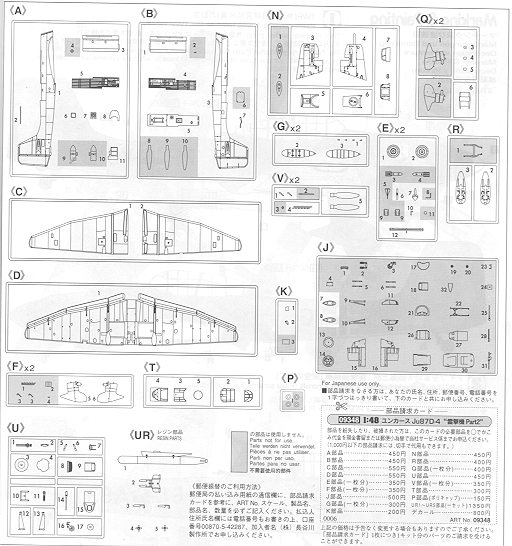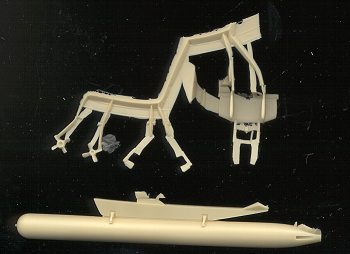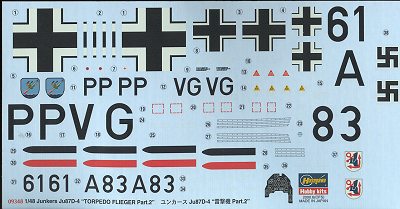
|
KIT: |
Hasegawa 1/48 Ju-87D-4 'Torpedo Flieger' |
|
KIT # |
09348 |
|
PRICE: |
$32.98 |
|
DECALS: |
Two aircraft |
|
REVIEW & |
|
|
NOTES: |
|

|
HISTORY |
A real work horse of the Luftwaffe is a good way of describing the Ju-87. In action from the first to the last days of the war, it was often called upon to perform other functions than that for which it was originally designed. One of them was as a torpedo bomber. Unlike most of the other variants, this one was quite short lived. The main reason was that there were so many other capable aircraft like the He-111 and Ju-88 that were better suited to the task.
Finding historical information was a real challenge. In fact, I could find little other than a footnote or two on the fact that the D-4 was converted from existing D-1 and D-3 airframes and soon converted back. All agree that there were very few dedicated D-4s actually built. The most information I have found on the subtype comes from the kit instructions and I'll paraphrase those to give you some insight into the aircraft.
The prototype D-4 was originally the prototype D-1 aka Ju87v24, itself a modification of a Ju-87B-1. The D-4 was believed to be exclusively a torpedo bomber carrying the superb Italian LT F5w torpedo of 950 kg. There is evidence that there was a field conversion set that would allow other versions to carry a torpedo should the need arise.
The D-4 was equipped with a heavy duty ordnance rack and carried drop tanks under each wing. Dropping altitude was much higher than the Japanese used. Japanese torpedoes were generally dropped around 10 meters whereas the Italian and German variety could be dropped between 40 and 100 meters. This was due to the control fins on the torpedo that corrected the attitude of the torpedo as it fell. The torpedo had an analog on-board targeting system was generally magnetically detonated.
|
THE KIT |

Hasegawa has always gotten excellent mileage out of it's kits and this Ju-87 variant is no exception. There are no new parts; all of what is in the kit having been released in other issues. What you do get are three bags full of bits. One has the decals and clear parts in it, one is absolutely jam packed with sprues, and what wouldn't fit in that bag is in another, along with the smaller bag of resin bits.
Allow me to say that the kit is in medium grey plastic with finely engraved panel lines. The fit is undoubtedly as good on this kit as it was on the Ju-87B that I built last year. Instructions are 14 construction steps and are very clear and easy to understand. There is also a parts diagram and a paint chart using Gunze paints and giving RLM equivalents.
 All of the resin
parts are for the torpedo and its launch rack. The resin looks pretty good and
should not present any problems during construction. There really are an awful
lot of parts for this kit. Many of them you won't be using as they are not germane
to the D subtype. As many of you already know, the major fuselage and wings are
the same between the B and early D versions, the major changes being the new
engine, wheel pants, underwing radiators, and tailplane braces. It is the later
versions of the Ju-87D that have the longer span wings, and those are not part
of this kit.
All of the resin
parts are for the torpedo and its launch rack. The resin looks pretty good and
should not present any problems during construction. There really are an awful
lot of parts for this kit. Many of them you won't be using as they are not germane
to the D subtype. As many of you already know, the major fuselage and wings are
the same between the B and early D versions, the major changes being the new
engine, wheel pants, underwing radiators, and tailplane braces. It is the later
versions of the Ju-87D that have the longer span wings, and those are not part
of this kit.
If you look at the drawing of all the kit sprues, you will see that you are going to have a lot of extra parts for your goodie bin after this one is built! The kit shows the dive brakes and sirens being added to this aircraft, but I'm not sure if those items would have been required for a torpedo bomber. The instructions also show the bomb swing arm attachments and again, I don't think those would have been included on a torpedo bomber. It will be up to the modeler to decide if those items should be included. I could not find any photographs of the Ju-87D-4 so cannot verify that those items would have been installed.
 Decals are not
typical of Hasegawa kits. For one thing, they are not as thick as one normally
expects, and it appears that the white is actually white and not cream. Good
thing as there are no aftermarket ones for this variant. You get two different
aircraft on the sheet. One is a standard RLM 70/71/65 painted aircraft of the
Torpedo Research Facility. It has a nice unit badge on the nose as well as the
radio code letters PP+VG. The other is listed as a 'torpedo bomber training
aircraft', and the paint scheme given is hypothetical. It is shown as either RLM
65 or 76 overall with code letters 61+A83.
Decals are not
typical of Hasegawa kits. For one thing, they are not as thick as one normally
expects, and it appears that the white is actually white and not cream. Good
thing as there are no aftermarket ones for this variant. You get two different
aircraft on the sheet. One is a standard RLM 70/71/65 painted aircraft of the
Torpedo Research Facility. It has a nice unit badge on the nose as well as the
radio code letters PP+VG. The other is listed as a 'torpedo bomber training
aircraft', and the paint scheme given is hypothetical. It is shown as either RLM
65 or 76 overall with code letters 61+A83.
Overall, it is bound to be a super model when you get it finished and will be a little bit different from the hoards of Luftwaffe aircraft seen at shows and contests.
Review copy courtesy of Marco Polo Importers
If you would like your product reviewed fairly and quickly by a site that has over 1,000 visits a day, please contact me or see other details in the Note to Contributors.